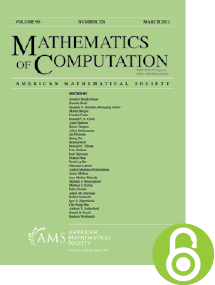A method of tabulating the number-theoretic function $g(k)$
HTML articles powered by AMS MathViewer
- by Renate Scheidler and Hugh C. Williams PDF
- Math. Comp. 59 (1992), 251-257 Request permission
Abstract:
Let $g(k)$ be the least integer $> k + 1$ such that all prime factors of $\left ( {\begin {array}{*{20}{c}} {g(k)} \\ k \\ \end {array} } \right )$ are greater than k. The function $g(k)$ appears to show quite irregular behavior and is hard to compute. This paper describes a method of computing $g(k)$, using sieving techniques, and provides a table of values of $g(k)$ for $k \leq 140$.References
-
L. E. Dickson, History of the theory of numbers, vol. 1, Chelsea, New York, 1966.
E. F. Ecklund, Jr., P. Erdős, and J. L. Selfridge, A new function associated with the prime factors of $\left ( {\begin {array}{*{20}{c}} n \\ k \\ \end {array} } \right )$, Math. Comp. 28 (1974), pp. 647-649.
P. Erdős, Some problems in number theory, Computers in Number Theory (A. O. L. Atkin and B. J. Birch, eds.), Academic Press, London, 1971, pp. 405-414.
- P. Erdos, Uses of and limitations of computers in number theory, Computers in mathematics (Stanford, CA, 1986) Lecture Notes in Pure and Appl. Math., vol. 125, Dekker, New York, 1990, pp. 241–260. MR 1068538
- A. J. Stephens and H. C. Williams, An open architecture number sieve, Number theory and cryptography (Sydney, 1989) London Math. Soc. Lecture Note Ser., vol. 154, Cambridge Univ. Press, Cambridge, 1990, pp. 38–75. MR 1055399
Additional Information
- © Copyright 1992 American Mathematical Society
- Journal: Math. Comp. 59 (1992), 251-257
- MSC: Primary 11Y70; Secondary 11N36
- DOI: https://doi.org/10.1090/S0025-5718-1992-1134737-X
- MathSciNet review: 1134737


